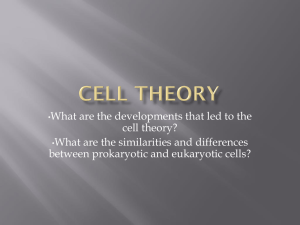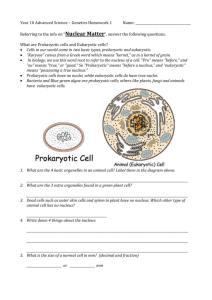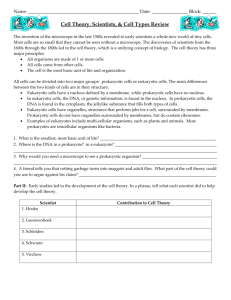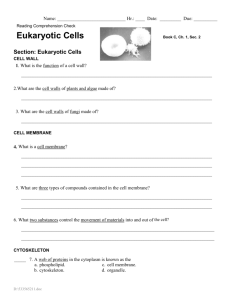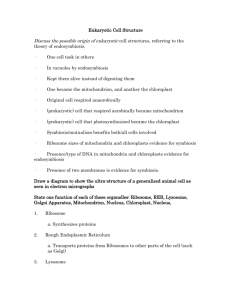SYNTHISIS
advertisement
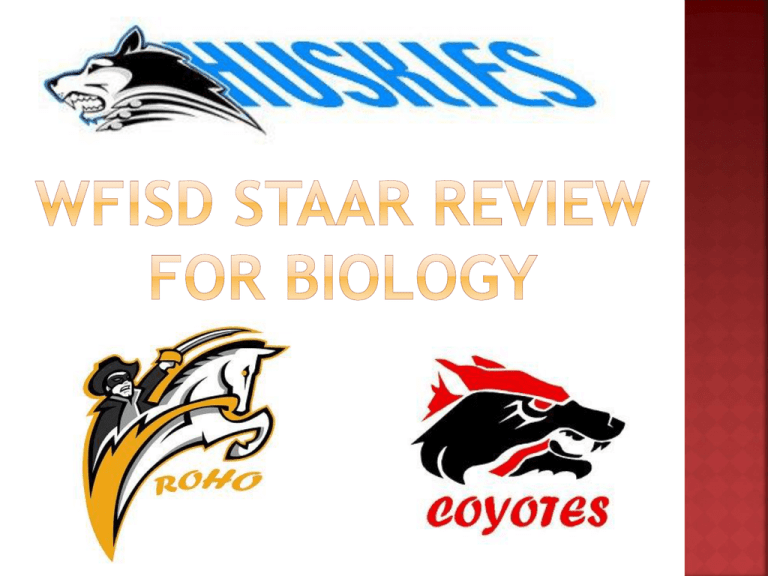
Question #1: What is the difference between a prokaryotic & an eukaryotic cell? A. A prokaryotic cell is normally a single cell & has a nucleus. B. An eukaryotic cell is found in multi-celled organisms & has no nucleus. C. A prokaryotic cell has no defined nucleus. D. An eukaryotic cell has no defined nucleus. Question #2: Which of the following may be found in all prokaryotic & eukaryotic cells? A. cell wall B. plasma membrane C. nucleus D. chloroplasts Question #1: All cells must maintain a relatively stable internal environment despite changes in the external environment. What is this called? A. automaticity B. homeostasis C. metabolism D. physiology Question #2: Cell membranes perform all the following functions except: A. making nutrients for cells. B. holding cytoplasm within cells. C. regulating substances exiting cells. D. recognizing other cells. Outer Covering Genetic Material Virus Eukaryotic Cell Protein capsid (some w/envelope) DNA or RNA (ds or ss) Cell membrane + cell wall in some Organelles Nope Reproduction Must have host DNA (ds) Yesmembranebound Multiply on own Question #1: The viruses that cause influenza tend to change over time, necessitating the development of new flu vaccines. Changes in the characteristics of the viruses are caused by changes in which structure? A. ribosomes B. nucleic acids C. the cell membrane D. the rough endoplasmic reticulum Question #2: How should drawings of a cell & a virus differ? A. only the virus would have cilia B. only the virus should have a nucleus C. only the cell should have organelles D. only the cell should have genetic material T= two cells T= total chromosomes Question #1: A DNA molecule carries information that determines an animal’s fur color. Where can copies of this molecule be found in the organism’s body? A. in the sex cells only B. in specialized fur cells only C. only in the organism’s epithelial cells, including fur cells D. in all of the organism’s body cells, but only in some of its sex cells Question #2: Mitosis is a very complex process with several steps. During this process, at which phase does the formation of the nuclear membrane occur? A. B. C. D. prophase metaphase anaphase telophase Question #1: Vascular plants transport nutrients through specialized structures called xylem & phloem. What is the purpose of xylem? A. they take water & nutrients from the soil B. they allow water & nutrients to move from the root through the plant C. they capture the sun’s energy to make sugar D. they move sugars & other nutrients from the leaves to the roots Question #2: The cells of skeletal muscle are long & cylindrical. Red blood cells are small & round. Which statement best explains why the two types of cells have different structures? A. The blood cells erode as they move through the body. B. The muscles are stretched each time they contract. C. The blood cells & muscle cells are both shaped to suit their function. D. The blood cells & muscle cells are made in different parts of the body. Question #1: A scientist wants to learn how humans develop several distinct types of muscle cells. The scientist should study which of the following phenomena? A. meiosis B. photosynthesis C. selective expression of genetic material D. the effect of environmental conditions on cellular respiration Question #2: Proteins are the most varied & complex organic compounds. What determines how proteins are produced to perform their many functions? A. DNA provides instructions for constructing the needed proteins. B. Enzymes control how proteins are assembled & constructed. C. Hormones provide the information to change protein function. D. Cell nuclei assemble & then give instructions to construct proteins. Question #1: What kind of cells most likely result from uncontrolled growth due to mutations in genes that control the cell cycle? A. nerve cells B. bone cells C. cardiac cells D. cancer cells Question #2: Which statement does not describe cell cycle checkpoints? A. Normal checkpoints assess damage to DNA. B. Faulty checkpoints may lead to abnormal cell growth. C. Cell checkpoints can fail during mitosis & meiosis. D. Defective checkpoints result in the death of the cell. Question #1: Which biomolecule is the resulting product when a polypeptide chain is broken down? A. a fatty acid B. a nucleotide C. an amino acid D. a simple sugar Question #2: Chemicals present in fungi that break down plant material are most likely members of which group? A. carbohydrates B. proteins C. nucleic acids D. fats Question #1: A student designs a model of a DNA molecule. In order to demonstrate how the molecule codes for different traits, it is most important for the model to show which detail of the molecule? A. the molecule’s length B. the number of genes in the molecule C. the sequence of nitrogenous base pairs D. the chemical structure of deoxyribose Question #2: The Miller-Urey experiment showed: A. how life formed on a young Earth. B. early Earth had the right ingredients for amino acids to form. C. how life can evolve into complex lifeforms. D. how animals die according to survival of the fittest.

